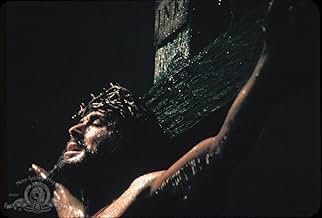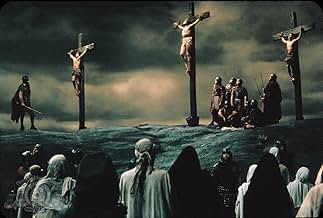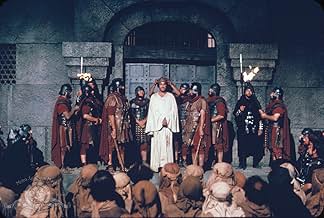Ein All-Star, großformatiger Epic-Film, der das Leben und Wirken Jesu Christi dokumentiert.Ein All-Star, großformatiger Epic-Film, der das Leben und Wirken Jesu Christi dokumentiert.Ein All-Star, großformatiger Epic-Film, der das Leben und Wirken Jesu Christi dokumentiert.
- Für 5 Oscars nominiert
- 1 Gewinn & 6 Nominierungen insgesamt
Handlung
WUSSTEST DU SCHON:
- WissenswertesTelly Savalas Though it is reported all over the internet that Telly Savalas shaved his head bald for his role as Pontius Pilate in this movie, he had actually shaved it first for Fanfare For A Death Scene (1964) in which he played a Mongolian warlord. He kept it shaved for the rest of his life.
- PatzerDifferences from the source material are not considered to be goofs, especially when relating to dramatic decisions. Many historical inaccuracies also get a pass, especially when caused by reliance on religious and/or artistic traditions.
- Zitate
Jesus: Do not weep for me; weep for yourselves, and for your children. For a time is coming when men will say "blessed are the barren, the wombs that never bore a child." And they will say to the mountains "fall on us," and to the hills "cover us," for if these things are done when the wood is green, what will happen when it is dry?
- Alternative VersionenOriginal Cinerama version ran 260 minutes, subsequently cut over the years. The shortest version runs 141 minutes. Numerous versions have been shown on television. Network television print has only the main cast credits at the beginning and the technical credits at the end shown page-by-page (not "rolled up" as most prints), including a credit for "Cinerama". The most common version of the film shown today runs 195 minutes with all the credits rolled up at the beginning, and the end titles showing only the words "Released through United Artists". That particular version has been available on home video and cable TV.
Ausgewählte Rezension
As someone who had read the Bible and knows what goes where, I am easily critical of too-Liberal Biblical movies, which is usually the case....except for the last 40-some years when hardly any films were made on this subject at all.
My point is that this film gets toasted a lot, even by Christians, and I think unfairly. Yes, I became a bit annoyed the first few viewings when I would hear Jesus' speeches way out of order, or a few other things that really weren't 100 percent on the mark....or it just simply dragged.
However, after a long absence and my first look at this on the ultra widescreen (2.75:1) DVD, I was impressed. For instance, the scene with the Last Supper shows everyone at the table, which is impossible to do in a formatted-to-TV mode. There are other similar panoramic shots that are very impressive. gave me a new appreciate of the work director George Stevens did here. Of course, he was one of the best in his profession so it's no surprise this is nicely filmed.
Upon that recent viewing, I was please that none of Jesus' quotes are inaccurate and I have never had a problem with Max Von Sydow's portrayal of Christ. He had a penetrating eyes and spoke his lines with authority. Why he, too, gets bashed by a few people is unfair. He was just fine.
It's a sanitized message, nothing that "preachy" to turn off the unchurched, but I do think it was a bit too slow to go three hours and 20 minutes. In this case, lopping off 15-30 minutes might have helped. It's still worth viewing, no matter what your "religious" views.
My point is that this film gets toasted a lot, even by Christians, and I think unfairly. Yes, I became a bit annoyed the first few viewings when I would hear Jesus' speeches way out of order, or a few other things that really weren't 100 percent on the mark....or it just simply dragged.
However, after a long absence and my first look at this on the ultra widescreen (2.75:1) DVD, I was impressed. For instance, the scene with the Last Supper shows everyone at the table, which is impossible to do in a formatted-to-TV mode. There are other similar panoramic shots that are very impressive. gave me a new appreciate of the work director George Stevens did here. Of course, he was one of the best in his profession so it's no surprise this is nicely filmed.
Upon that recent viewing, I was please that none of Jesus' quotes are inaccurate and I have never had a problem with Max Von Sydow's portrayal of Christ. He had a penetrating eyes and spoke his lines with authority. Why he, too, gets bashed by a few people is unfair. He was just fine.
It's a sanitized message, nothing that "preachy" to turn off the unchurched, but I do think it was a bit too slow to go three hours and 20 minutes. In this case, lopping off 15-30 minutes might have helped. It's still worth viewing, no matter what your "religious" views.
- ccthemovieman-1
- 14. Juni 2006
- Permalink
Top-Auswahl
Melde dich zum Bewerten an und greife auf die Watchlist für personalisierte Empfehlungen zu.
- How long is The Greatest Story Ever Told?Powered by Alexa
Details
Box Office
- Budget
- 20.000.000 $ (geschätzt)
- Laufzeit4 Stunden 20 Minuten
Zu dieser Seite beitragen
Bearbeitung vorschlagen oder fehlenden Inhalt hinzufügen

Oberste Lücke
What is the streaming release date of Die größte Geschichte aller Zeiten (1965) in Australia?
Antwort




































